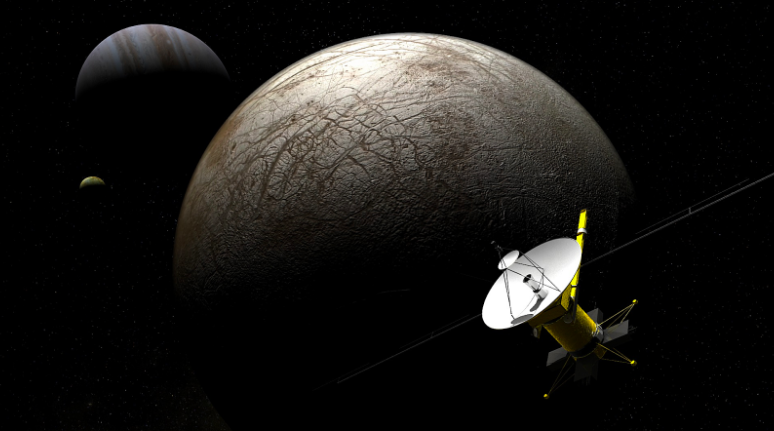NASA’s Europa Clipper mission successfully launched on October 14, 2024, aboard a SpaceX Falcon Heavy rocket, departing on a nearly six-year journey to explore Jupiter’s moon, Europa. The mission aims to determine whether Europa has the right conditions to support life, a critical question in astrobiology.
At liftoff, the Europa Clipper weighed about 12,500 pounds, nearly half of which was propellant. Once the spacecraft’s solar panels unfolded, it spanned over 100 feet, slightly longer than a basketball court, making it the largest spacecraft NASA has developed for a planetary mission.
The spacecraft is scheduled to arrive in the Jupiter system in April of 2030, where it will perform nearly 50 flybys of Europa. At its closest point, the Clipper will come within 16 miles (25 kilometers) of the moon’s surface, allowing for detailed measurements and observations. “Europa is certainly the most likely place for life beyond Earth in our solar system,” Robert Pappalardo, the project scientist for the Europa Clipper, said in The New York Times.
Europa’s surface is identified by a thick ice shell, which is believed to cover an extensive ocean of liquid water beneath. This subsurface may contain twice the amount of water found in all of Earth’s oceans combined. The Clipper’s main goals include investigating the ice shell and the ocean beneath it, analyzing Europa’s structure and geology, and understanding the moon’s potential to sustain life.
The mission carries nine sophisticated instruments, including cameras, spectrometers, and an ice-penetrating radar system, designed to analyze the moon’s surface and subsurface. One of the mission’s key instruments, the radar, will search for liquid water and detect any embedded lakes or cryovolcanoes that may exist. The Europa Clipper’s design also includes strong radiation protection, which is vital due to Jupiter’s harsh environment. All of the spacecraft’s equipment is kept in a thick vault, a method used successfully in the earlier Juno mission launched to study Jupiter. This shielding is crucial for protecting its electronics from Jupiter’s powerful radiation.
The spacecraft’s journey to launch was long and complex, involving decades of planning and advocacy. First planned in the mid-1990s, the mission encountered many challenges, including changes in NASA’s priorities and discussions about the spacecraft’s design and launch. However, the mission gained traction, leading to its recent successful launch.
Looking ahead, the Europa Clipper is set to improve our understanding of Europa and other ocean worlds in our solar system. On Space.com, Bonnie Buratti, the deputy project scientist, explained, “We’re looking for a habitable environment and signs of the ingredients for life, not life itself.” Signs of potential habitability that the Europa Clipper will look for include key ingredients like carbon and oxygen, organic compounds, and evidence of a subsurface ocean. With its findings, the Europa Clipper could open the door for future missions to explore the mysteries of life beyond Earth.
As the mission unfolds, scientists are optimistic that the Europa Clipper will deliver key data that could change our understanding of what makes a place capable of supporting life in the solar system. This could represent an important advancement in the ongoing expedition to find life beyond Earth.














































































































































